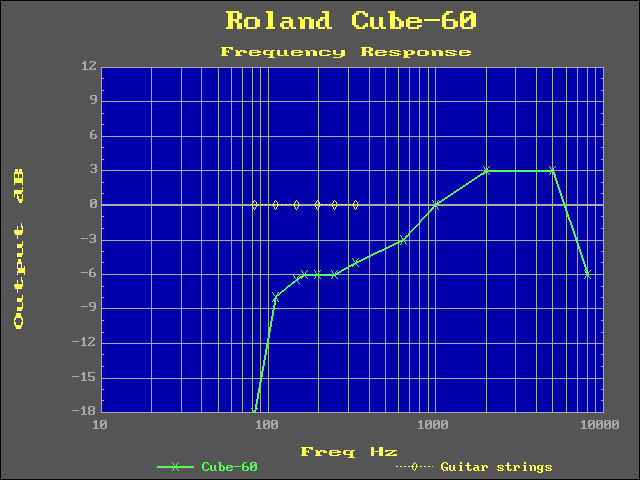
Errata: the title and caption should read Cube-40
| <<<OzValveAmps
http://www.ozvalveamps.org/repairs/cube40.html | Last update: 22:36 14/01/06 |
Not the goods.
This amp was purchased with the keyboard, suggested by the shop.
model: SCL-40The Cube-40 is well named. 40 watts in about one cubic foot, a good-looking unit of the practice amp class.
This particular one had a small tear in its speaker dome, and a broken wire in the reverb spring line. The reverb springs are mounted on a sub-chassis itself suspended on springs. The fine wires that carry the signals across this gap frequently break, silencing the reverb.
I had played synth through this amp before and noted that it seemed to die very rapidly in the octave below middle-C (about 250Hz). Since it was on the bench for these other troubles I took the opportunity to take some measurements to find out what was actually happening.
I had assumed that the problem would be simply a lack of speaker response due to the small sealed speaker enclosure and that it could still be used as on-stage foldback for the player, and we could give it legs by taking a DI(*) feed from its Line Out to the PA.
It was a reasonable assumption, but it turned out to be wrong.
With reference to 0dB @ 1KHz and all tone controls “flat” the response of the amplifier falls steadily from 1KHz;
1KHz 0dB reference 642Hz -3dB(V) half power point 246Hz -6dB(V) quarter power point 163Hz speaker self resonance
This confirms the impression that output falls rapidly below middle-C (256Hz).
The amp output also rises above 1KHz (2 octaves above middle-C) which means that it's output is already starting to roll off even in the top synth octave.
Using the amp to drive the Siamese horn (which is flat down to about 40Hz) confirmed that even with maximum bass boost the amp itself has negligible output below middle-C.
This means that even DI-ing the amp to the PA won't improve matters.
If this were not enough, the output of the speaker itself drops like a stone (-24dB per octave) below its resonant frequency, in this case in the octave below middle-C.
Since the open top E string on a guitar is about 360Hz this would seem to be unsuitable for anything other than screaming lead guitar, piccolo, or cymbals.

I seem to encounter an endless stream of grumpy keyboard players with shoebox amplifers pushed at them by the “experts” at some music store.
The cold hard fact is that a small amp is simply physically incapable of reproducing bass, and no amount of bass boost is going to change that.
Keyboards actually have the most demanding requirements needing flat wide bandwidth response more like Hi-Fi.
(*) DI - Direct Interface connection to PA system.
|
|